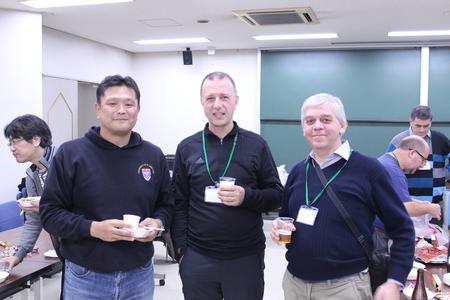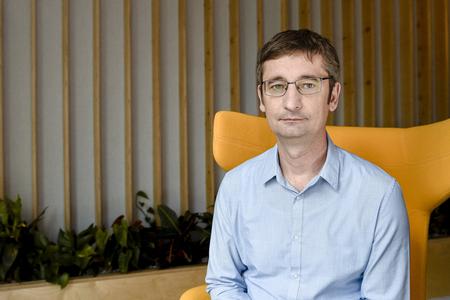If you are a budding wedding planner, you might want to learn a thing or two about the recently announced Slovak Scientist of the Year's area of research. Men will soon be able to receive a better prostate cancer diagnosis.
This article is supported by the ESET Foundation, whose annual ESET Science Award recognises exceptional scientists.
Another mission Slovak engineers have participated in has been launched into space.
Meanwhile, the Slovak Academy of Sciences is celebrating the 70th anniversary of the Act on the Slovak Academy of Sciences, which has defined the foundations and form it exists in today.
The Slovak Spectator asked the scientists about their research and how it can contribute to society – and in this summary you will learn about the progress they have made.
This overview of the successes in Slovak science will be regularly compiled. To stay up to date with what scientists in Slovakia and Slovak scientists around the world are doing, subscribe to the Slovak Science newsletter, which will be sent to readers free of charge four times a year.
Not your usual graphs
If you are a budding wedding planner, you might consider picking up graph theory. Well, graphs are not just bars in voting preferences polls. In maths, graphs consist of two elements - vertices and lines called edges that connect two such vertices.
According to mathematician Martin Škoviera, the subject of research are the structures that arise - the relationships between the vortices represented by the edges.
Say a lot of chemicals need to be stored in a warehouse, but for safety reasons, some cannot be in the same room due to the risk of an explosion – this problem can be solved using a graph.
In May, Škoviera was named the 2022 Slovak Scientist of the Year for his contributions to graph theory. In an interview, he talks about his work and the successes of Slovaks in the field.

Improved cancer diagnosis
Slovak researchers from the company Glycanostics have come up with new method for the detection of prostate cancer. The uniqueness of the diagnostic method lies in determining the structure of glycans, or complex sugars.
The current standard is the PSA test. However, it is unreliable, with a low accuracy of around 68 percent, meaning the analysis may leave the urologist unable to decide whether the increased values of PSA are due to inflammation, a benign disease, or cancer. This is usually followed by a biopsy, and generally 73 percent of procedures turn out negative, or in other words were unnecessary.
In comparison, the new method allows for the very precise detection of even early-stage cancer, quick and reducing the number of false positive results.
Recently, the method was clinically tested in the EU. Men can already pay for the test in selected ambulances. Glycanostics expect the availability of the method to increase by the end of 2023.
Learn more about the method in an older interview with the Eset Science Award laureate and company founder.

Additionally, Glycanostics has recently received €2.5 million in funding to develop the screening technology for other types of cancer such as breast, pancreatic and lung.
Leaving a mark in space
In the middle of April, the JUICE space probe was launched into space. Its goal is to study Ganymede, Callisto, and Europa, three of Jupiter's so-called Galilean moons. Each is thought to contain huge oceans of liquid water under their icy surfaces.
Onboard the spacecraft are many scientific instruments, one being an instrument worked on by Slovak researchers and engineers from the Institute of Experimental Physics of the Slovak Academy of Sciences in Košice.
Called the Particle Environment Package, or PEP, the device is designed to study the magnetosphere of Jupiter and how it interacts with its moons.
However, the magnetosphere captures a large number of charged particles that can penetrate the shielding of the probe and result in false detections by the instruments. The Slovak engineers created a detector that allows the false detections to be discounted.

Overview of other research and development activities in universities:
The Slovak Academy of Sciences (SAV) is celebrating the 70th anniversary of its foundation. Today SAV ranks with standard European scientific institutions in terms of both level and focus. Read more. In a 2022 interview, SAV head Pavol Šajgalík talks about how science in Slovakia has changed in the last decades.
The prevalence of HIV, selected blood-borne and sexually transmitted infections in migrants in Slovakia; Comenius University; lead scientist Alexandra Bražinová. The aim of the project was to map the incidence of Hepatitis B and C, HIV and Syphilis among foreigners in Slovakia. People coming to Slovakia from other countries are more susceptible to several diseases, including those that can be prevented by vaccination.
miRNA as potential biomarkers in adolescent major depression disorder; Comenius University; lead scientist Juraj Mokrý. The pathophysiological mechanisms of depression are still not completely known and certain differences between children and adults are assumed. Since up to one third of patients do not respond to therapy, the goal is to find measurable parameters that would contribute to the diagnosis and determine its prognosis and response to therapy. Read more.
Continuous monitoring of suicide mortality in the Slovak population; Comenius University; lead scientist Alexandra Bražinová. The article presents an overall slightly declining rate of suicide mortality in Slovakia. However, undetermined intended deaths are significantly rising and is several times higher than the rest of the EU. Moreover, there is a high probability that suicides have been included in the latter group. Read more.
Why are snowdrop flowers turned downward? Comenius University and SAV; lead scientist Pavol Prokop. The spring snowdrop is special because its flower is turned downwards. Since it is an insect-pollinated species, the flower should, among other things, be able to attract pollinators and be turned upwards. The team of scientists wanted to investigate why it is the other way around with the spring snowdrop. Read more.
Other Slovak science stories on Spectator.sk:
ARTIFICIAL INTELLIGENCE: When it comes to teaching artificial intelligence to use the Slovak language, researchers face a drawback. With a relative absence of data in the language, it is difficult to train. That is where the efforts of Slovak researchers from the Technical University of Košice come in.
MEN'S HEALTH: Prostate cancer is the most common oncological disease in men. A urologist from the town of Martin has joined an international team of researchers with the goal of improving the treatment so that it is more comfortable, precise and without side effects.
INTERVIEW: In 2020, Emmanuelle Marie Charpentier made history when she picked up the first science Nobel Prize ever won by solely two women. The Slovak Spectator talked to her about the microbial universe, the mistaken belief that humans are at the top of the food chain, and the potential for a bacterial, or fungal, pandemic.
FESTIVAL: Queen guitarist and astrophysicist Brian May, and biologist Jane Goodall who studied primates, are two of the many names that the Starmus festival, which combines science, art and music, will bring to Slovakia next year in May.
This article is supported by the ESET Foundation, whose annual ESET Science Award recognises exceptional scientists.



 Stock image. (source: Unsplash/Louis Reed)
Stock image. (source: Unsplash/Louis Reed)